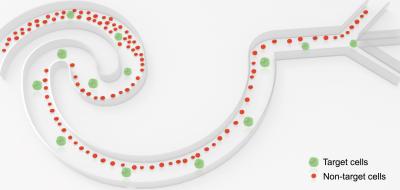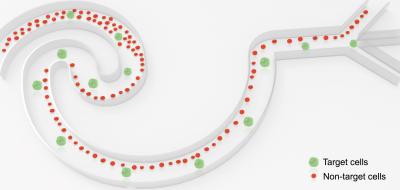
Credit: SUTD
Nearly half a century ago scientists have noticed an interesting phenomenon that small particles flowing through a long tube can stay at a specific position along the cross-section of a tube. This is known as inertial focusing. Later, along with the development of microfluidic technology in recent decades, inertial focusing (one type of passive microfluidic manipulation technology) has emerged as one of the most powerful and precise cell manipulation techniques, exhibiting immense commercial potentials in the bioengineering and pharmaceutical industries. Assistant Professor Dr Ye Ai's research team from the Singapore University of Technology and Design (SUTD) recently developed a novel, credit card sized inertial cell focusing and sorting microfluidic device with a channel of 125 μm wide (roughly half of a single fingernail's thickness), providing the potential of rare cell isolation from complex clinical samples.
Currently cancer is becoming one of the leading causes of human death. One of the major difficulties towards achieving radical cure in cancer is due to malignant metastasis, which directly causes overwhelming obstacles in therapeutic management and early diagnosis. The ability to isolate rare circulating tumor cells (CTCs), the seeds for cancer metastasis, enables much less invasive approach for cancer diagnosis and prognosis. New microfluidic technologies for high throughput, high accuracy cell sorting of complex biological samples are highly sought after to address the challenge in rare cell isolation.
In this research, Dr Ai's team presented a novel inertial focusing and sorting device with a series of reverse wavy channel structures consisting of semi-circular sections that generate a periodically reversed hydrodynamic flow perpendicular to the main flow direction. The balance between two kinds of hydrodynamic forces resulted in a size-dependent lateral particle movement across the channel, which finally achieved size-based separation of target cells from non-target cells. The principal investigator, SUTD's Dr Ai said: "Compared to active methods, the passive inertial focusing with the use of hydrodynamic forces exhibit the merits of a simplified setup, high-throughput and low-energy consumption. Moreover, the linear array of these repeated wavy channel units also facilitates easy horizontal (2D) and vertical (3D) parallelization of multiple channels, which provides great potential for high-throughput cell sorting in practical biomedical applications." The team has applied the developed sorting technology for high-throughput isolation of cancer cells from whole blood samples.
###
This work has been published in Nature's Microsystems & Nanoengineering journal, which is focused on research in all aspects of Micro and Nano Systems. Two SUTD graduate students (Yinning Zhou and Zhichao Ma) participated in this research project.
Media Contact
Melissa Koh
[email protected]
65-649-98742
http://www.sutd.edu.sg
Related Journal Article
http://dx.doi.org/10.1038/s41378-018-0005-6




